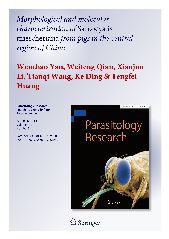摘要
Sarcocystosis is an important food-borne parasitosis in humans and various animals. Sarcocystis miescheriana and Sarcocystis suihominis are pathogenic to pigs; S. suihominis is also distinctly pathogenic to humans. Intermediate and final hosts can harbor more than one Sarcocystis species, so the exact identification for Sarcocystis infection in various hosts is essential to control sarcocystosis in humans and important economic animals including pigs. In this study, four isolates of sarcocysts from slaughtered pigs (SmJY1-SmJY4) in the central region of China, in Henan province, were collected and examined by transmission electron microscopy and 18S rRNA sequence analysis to identify the Sarcocystis species in pigs in China. The results showed that cysts in the diaphragm muscles have a thick cyst wall with a number of palisade-like protrusions up to 4.38 mu m in length. Inside these protrusions, there were 13-16 fibrils per protrusion. Bradyzoites in cysts showed typical characteristics of Apicomplexa including a conoid, many micronemes, dense bodies, one big nucleus, and a number of amylopectin granules. These ultrastructural results suggest that characteristics of tissue cysts of the isolates SmJY1-SmJY4 were similar to those of S. miescheriana. The sequence similarities of SmJY1-SmJY4 with S. miescheriana were 99-99.5 %, and the sequence similarities of SmJY1-SmJY4 with S. suihominis were much lower. Results of the ultrastructural observation in combination with molecular characterization based on the 18S rRNA sequence represent the first demonstration of S. miescheriana in pigs in China. In addition, results of the histological examination showed that the cysts of S. miescheriana had two types of cyst wall, a palisade-like thick wall and another smoothly thin wall, and could cause obvious atrophy, degeneration, and necrosis of muscle fibers in the diaphragm of naturally infected pigs. These findings will provide an important reference for the examination of Sarcocystis species in the slaughter quarantine of live pigs and in the control of sarcocystosis in pigs.
- 出版日期2013-3
- 单位河南大学
